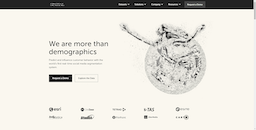User's Area

Spatial
Segment people & places based on social, mobile & web activity
What is Spatial?
Customer Behavior Prediction and Influence through Real-Time Social Media Segmentation
The goal of a real-time social media segmentation system is to understand and predict customer behavior based on their social, mobile, and web activities. By analyzing and categorizing individuals based on their online behavior, companies can gain valuable insights into their preferences, interests, and behaviors. This analysis can then be used to tailor marketing strategies, product offerings, and customer engagement techniques to better meet the needs and desires of specific customer segments.
The segmentation of people based on their social, mobile, and web activities offers a deeper understanding of consumer behavior. By examining the types of content individuals engage with, the frequency of their online interactions, and the platforms they use, businesses can create more targeted and effective marketing campaigns. This in-depth knowledge of customer behavior and preferences allows companies to personalize their interactions with customers, ultimately improving customer satisfaction and loyalty.
Furthermore, the segmentation of places based on the type and velocity of social activity in proximity to a location can provide valuable insights for businesses operating in physical spaces. By understanding the social dynamics of different locations, companies can make informed decisions about where to position their products, how to design their physical spaces, and how to engage with customers in those locations. This level of insight allows businesses to optimize their physical environments to better meet the needs and desires of their target customer segments.
Real-Time Insights for Targeted Marketing Strategies
The real-time nature of the social media segmentation system enables businesses to stay abreast of changing consumer behaviors and preferences. By monitoring social, mobile, and web activities as they unfold, companies can identify emerging trends, shifts in consumer sentiment, and changes in customer preferences. This enables businesses to adapt and tailor their marketing strategies in real time, ensuring that they remain relevant and appealing to their target audience.
Additionally, the ability to predict customer behavior based on real-time social media segmentation allows businesses to proactively engage with customers. By identifying patterns and trends in customer behavior, companies can anticipate their needs and desires, allowing for the timely delivery of personalized marketing messages, offers, and recommendations. This proactive approach can help businesses stay ahead of competitors and maintain a strong rapport with their customer base.
Furthermore, by influencing customer behavior through personalized marketing strategies, businesses can drive engagement and conversion rates. Tailoring marketing messages and offers to specific customer segments based on their online activities and preferences increases the relevance and effectiveness of these communications. This, in turn, can lead to higher levels of customer engagement, improved conversion rates, and ultimately, increased revenue for businesses.
Data-Driven Decision Making for Enhanced Customer Engagement
The real-time social media segmentation system facilitates data-driven decision making, allowing businesses to make informed choices about how to engage with their customers. By leveraging the insights gained from social, mobile, and web activities, companies can develop and refine their customer engagement strategies. This data-driven approach ensures that companies are investing their resources in initiatives that are most likely to resonate with their target audience, ultimately maximizing the impact of their marketing efforts.
Moreover, the real-time segmentation of customer behavior based on online activities enables businesses to continually refine and optimize their customer engagement techniques. By continuously monitoring and analyzing customer behavior, companies can identify the effectiveness of their current strategies, assess the impact of new initiatives, and make adjustments as needed. This iterative process of refinement ensures that businesses remain responsive to their customers' evolving needs and preferences.
In conclusion, a real-time social media segmentation system offers businesses the opportunity to gain deep insights into customer behavior and preferences, enabling them to predict and influence customer behavior. By leveraging real-time data and insights, companies can develop targeted marketing strategies, proactively engage with customers, and make data-driven decisions to enhance customer engagement. Ultimately, this can lead to improved customer satisfaction, increased loyalty, and higher revenues for businesses.